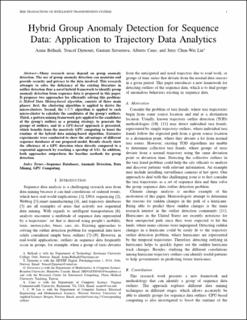Hybrid group anomaly detection for sequence data: application to trajectory data analytics
Peer reviewed, Journal article
Submitted version
Permanent lenke
https://hdl.handle.net/11250/3003769Utgivelsesdato
2021Metadata
Vis full innførselOriginalversjon
IEEE transactions on intelligent transportation systems. 2021. 10.1109/TITS.2021.3114064Sammendrag
Many research areas depend on group anomaly detection. The use of group anomaly detection can maintain and provide security and privacy to the data involved. This research attempts to solve the deficiency of the existing literature in outlier detection thus a novel hybrid framework to identify group anomaly detection from sequence data is proposed in this paper. It proposes two approaches for efficiently solving this problem: i) Hybrid Data Mining-based algorithm, consists of three main phases: first, the clustering algorithm is applied to derive the micro-clusters. Second, the kNN algorithm is applied to each micro-cluster to calculate the candidates of the group's outliers. Third, a pattern mining framework gets applied to the candidates of the group's outliers as a pruning strategy, to generate the groups of outliers, and ii) a GPU-based approach is presented, which benefits from the massively GPU computing to boost the runtime of the hybrid data mining-based algorithm. Extensive experiments were conducted to show the advantages of different sequence databases of our proposed model. Results clearly show the efficiency of a GPU direction when directly compared to a sequential approach by reaching a speedup of 451. In addition, both approaches outperform the baseline methods for group detection.
